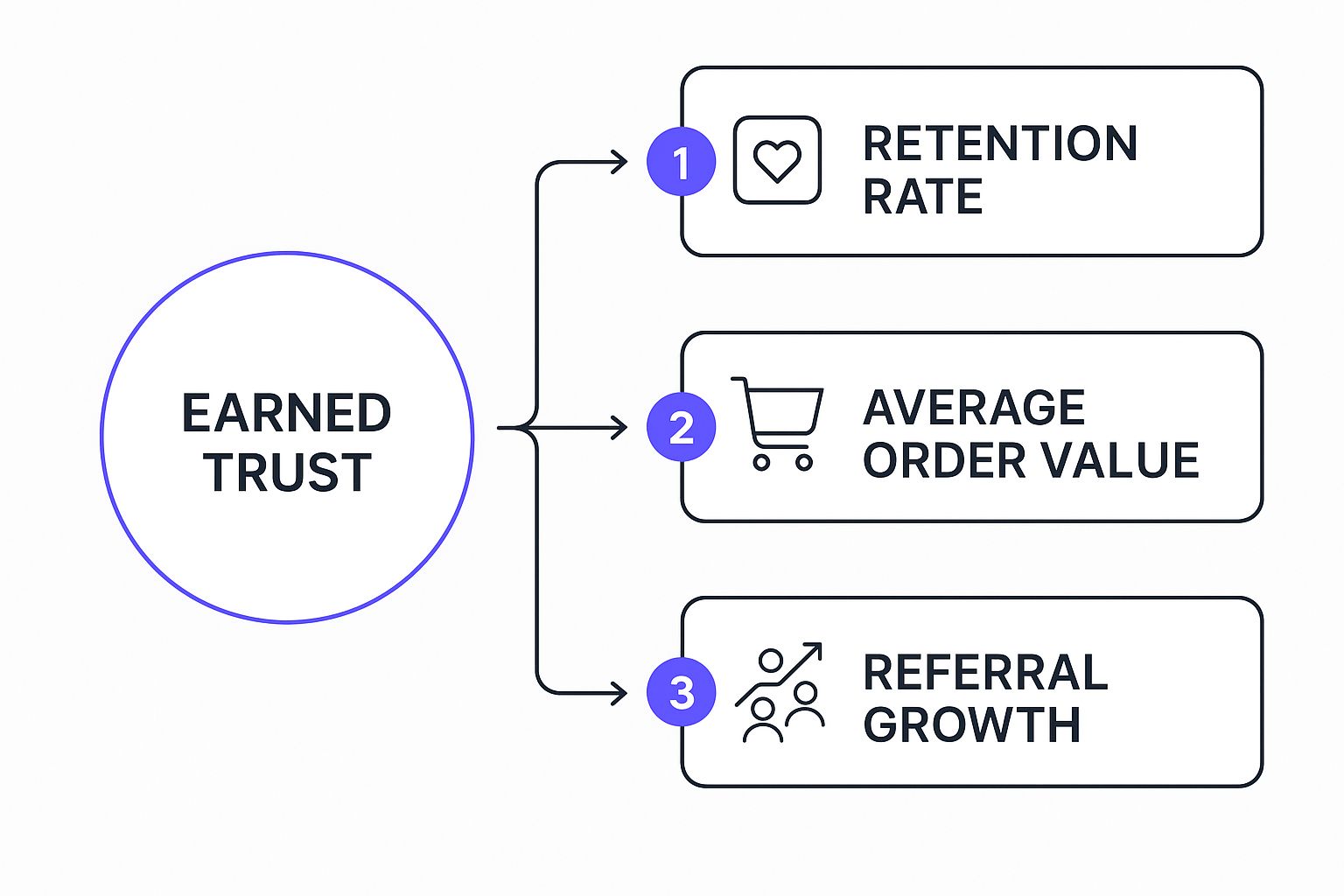How to Build Trust With Customers and Keep Them for Life

Building trust with customers isn't about a single grand gesture. It's the result of delivering consistent, transparent, and secure experiences, time and time again. This isn't just theory; we're moving straight into the real-world strategies that forge unbreakable customer bonds.
The Real Foundation of Customer Relationships
Let's be clear: customer trust isn't a "soft" metric. It's the absolute bedrock of sustainable growth.
When customers trust you, they're more willing to buy, far more likely to stick around, and quicker to forgive the occasional mistake. The numbers back this up—research shows that a staggering 87% of consumers will pay more for products from brands they genuinely trust. That's a direct line from trust to revenue.
Building this foundation isn't about flashy marketing campaigns. It’s about the small, consistent actions that prove you're reliable, day in and day out.
This guide zeroes in on three core pillars: radical transparency, unwavering consistency, and ironclad data security. Think of them as the legs of a stool—if one is weak, the entire structure wobbles.
The Three Pillars of Lasting Customer Trust
To really build lasting trust, you have to weave these principles into every single customer touchpoint, from their first glance at your website to every support ticket they submit.
| Pillar | Why It's Essential | Your First Action |
|---|---|---|
| Radical Transparency | It treats customers like partners, not just sales figures. Being open about everything from pricing to product roadmaps builds incredible goodwill. | Share your product roadmap publicly or create a "behind-the-scenes" update for your email list. |
| Unwavering Consistency | Every interaction must reinforce your brand's promise. A consistent experience across all channels proves you are reliable and professional. | Audit your customer journey. Does your website's tone match your support team's emails? |
| Ironclad Data Security | In an age of constant data breaches, showing a serious commitment to protecting customer info is non-negotiable. It’s a powerful signal of respect. | Review your privacy policy. Is it easy to understand? Make it simpler and more transparent. |
Mastering these pillars creates a resilient foundation that doesn't just survive market shifts—it thrives, turning casual buyers into lifelong advocates.
A brand is a promise. A good brand is a promise kept. Consistently keeping your promises is the fastest way to build unbreakable trust with your audience.
This all starts with a deliberate strategy, which often begins the moment a new relationship forms. A well-structured onboarding process is one of your first and best opportunities to prove your commitment to these principles. You can get a head start by exploring this detailed client onboarding process template to set the right tone from day one.
Mastering Transparency in Every Interaction
Let's get one thing straight: transparency isn't just about damage control. It’s not a card you play after you get caught. Real openness is a proactive strategy, a culture where sharing information—the good, the bad, and the work-in-progress—is just how you operate. If you're serious about learning how to build trust with customers, this is where it starts.
This means baking openness right into your brand’s DNA. Today’s customers are sharp. They can sniff out hidden fees, fuzzy promises, and corporate-speak from a mile away. When you share things upfront, you immediately lower their guard and invite them to be a part of your story, not just a consumer of your product.

This simple shift changes the entire dynamic. You’re no longer just making a transaction; you're building a partnership. Your customers stop feeling like another number on a spreadsheet and start feeling like valued insiders.
Demystify Your Pricing and Processes
Nothing destroys trust faster than hidden fees. A customer who feels tricked at checkout is a customer you’ll never see again. The fix? Simple, straightforward pricing that anyone can understand.
For example, a freelance consultant building their brand with MakerBox should have a crystal-clear "Services" page. Ditch the vague "Contact for pricing" line. Instead, offer tiered packages with explicit deliverables and costs listed right there. No surprises.
The same idea applies to your internal processes. Running a SaaS company? Share your product development roadmap and let users vote on what features they want next. Not only does this build incredible trust, but it also practically guarantees you're building something people will actually pay for.
Turn Setbacks into Trust-Building Moments
Every business hits a rough patch. Servers go down, supply chains get delayed—it happens. How you handle these moments is what truly defines your brand. Hiding the problem or pasting in a generic apology just pours fuel on the fire of customer frustration.
Instead, go for radical honesty. Let's say your SaaS platform has a 30-minute outage. A transparent response looks like this:
- Acknowledge it. Immediately. The second you know there's a problem, post it on your status page and social media.
- Give real-time updates. Share what you know, what you’re doing to fix it, and your best guess for a resolution. Keep people in the loop.
- Publish a post-mortem. After it's all fixed, write a quick, honest report explaining what went wrong and, more importantly, what you’re doing to make sure it doesn’t happen again.
This approach turns a potential PR nightmare into a powerful display of accountability. It shows you respect your customers enough to tell them the truth, which builds far more loyalty than a perfect track record ever could.
Showcase Your Values and Ethics
Transparency goes deeper than just operations and pricing. It’s also about being open about your company's values and ethics. Where do you source your materials? What are you doing about diversity and inclusion?
Sharing this kind of information lets customers connect with your brand on a human level. It proves you're not just a faceless corporation, but a group of real people trying to make a positive impact.
When you consistently practice this kind of openness, you create an environment where customers feel secure, respected, and genuinely connected to your mission. That’s how you solidify trust for the long haul.
Delivering Consistency Across the Entire Customer Journey
Trust isn’t a one-and-done deal. It’s earned slowly, through a whole series of predictable, positive moments.
When a customer’s experience feels seamless—whether they're scrolling your website, chatting with support, or using your product—they learn that your brand is reliable. But inconsistency? That creates doubt and friction, actively undoing all the trust you've worked so hard to build.
Think about it: a customer gets a friendly, casual marketing email but then runs into a rigid, jargon-filled support bot. That disconnect is confusing and makes the whole brand feel fake. The secret to learning how to build trust with customers is making sure every single touchpoint tells the same, cohesive story.

This alignment is the heart of brand consistency, a concept that’s about way more than just using the same logo and colors. To get the full picture, check out our guide on https://blog.makerbox.io/what-is-brand-consistency/ and why it’s so critical for growth.
Mapping the Journey to Find Friction
To deliver a consistent experience, you first have to understand what that experience actually is from your customer's perspective. This is where customer journey mapping becomes your best friend. It’s basically the process of visually laying out every interaction a customer has with your company, from the first time they hear about you to long after they've made a purchase.
Start by sketching out the main stages of your customer's lifecycle:
- Awareness: How do they first discover you? Maybe a social media ad or a blog post.
- Consideration: What happens when they’re checking you out? They’re probably visiting your site and reading reviews.
- Purchase: What's the actual buying process like? This covers everything from the checkout flow to onboarding.
- Service: How do you support them after the sale? Think help docs, live chat, or email support.
- Loyalty: What keeps them coming back and telling their friends? Newsletters and community forums are big here.
Once you have it all mapped out, you can start hunting for those points of friction. For example, a consultant using MakerBox might realize the professional, serious tone of their LinkedIn bio (generated by the tool) completely clashes with the quirky, casual vibe of their automated booking emails. It seems small, but that tiny inconsistency can be enough to make a potential client hesitate.
Unifying Your Cross-Channel Messaging
Your message needs to feel the same everywhere, from a big-picture marketing campaign right down to the tiny bit of text—the microcopy—in your app. That means your brand voice, the promises you make, and your core value prop should be consistent across the board.
Imagine a retail company that runs online ads promising "hassle-free returns." A customer buys something, tries to return it in-store, and is hit with a completely different, complicated policy. That broken promise doesn't just annoy them; it shatters trust instantly.
Real-World Scenario: A popular electronics retailer was getting hammered with negative reviews about their support. It turned out their online support team offered quick, no-questions-asked replacements, but the in-store staff followed a much stricter, more complex warranty process. Customers were, understandably, furious.
So, the company unified its policies. They trained the in-store staff on the more lenient online policy and gave them the power to process replacements just as easily. The result? Within three months, they saw a 15% decrease in negative support-related reviews and a noticeable increase in repeat purchases from customers who had gone through the new return process.
That simple move—creating a consistent, predictable experience—directly translated into renewed customer trust and loyalty.
Making Customer Data Protection Your Top Priority

How you handle customer data sends a powerful message about how much you respect them. This isn’t some back-office IT issue—it's a fundamental pillar of building real trust.
Every piece of information a customer shares, from their email to their personal preferences, is a leap of faith. The way you protect that information proves whether their faith was well-placed. Getting this wrong isn't just a technical glitch; it's a betrayal that can permanently poison your reputation and sink your bottom line.
There’s often a huge gap between how trusted companies think they are and how customers actually feel. Research shows a pretty jarring disconnect: while 90% of executives feel customers highly trust them, only 30% of consumers agree. This gap is almost always widest when it comes to data privacy.
Crafting a Clear and Honest Privacy Policy
Let’s be honest, your privacy policy is more than just legal padding to fend off lawsuits. It's a golden opportunity to be transparent and build confidence. Yet, most are filled with dense legalese that nobody reads or understands.
It’s time to change that. Rewrite your policy in plain English. Clearly state:
- What data you collect: Get specific, from names and emails to usage analytics.
- Why you collect it: Explain how this data helps you make their experience better.
- How you protect it: Briefly outline your security measures without getting lost in the weeds.
- Who you share it with: If you use third-party tools, be upfront about it.
A great way to show you’re serious is by having a comprehensive privacy policy that clearly maps out how you handle data. Here at MakerBox, we practice what we preach—you can see our straightforward approach in our own privacy information.
Giving Customers Control Over Their Data
Real trust isn’t built by just telling customers you’re protecting their data; it’s built by giving them the keys. When you provide clear, accessible tools for them to manage their own information, you’re showing respect for their autonomy.
Providing users with an easy-to-use dashboard where they can view, edit, or delete their personal information is a powerful trust signal. It shifts the dynamic from data collection to data collaboration.
If you’re a consultant using MakerBox, this could be as simple as a client portal where customers can update their contact info or communication preferences whenever they want.
This proactive approach isn't just about checking a compliance box; it's a real competitive advantage. It proves you see your customers as partners, not just data points to be mined. By making data protection a visible priority, you build a resilient foundation of trust that fuels long-term relationships and sustainable growth.
Turning Earned Trust Into Loyalty and Advocacy
Getting a customer to trust you is a huge win, but it's really just the starting point. The real magic happens when you turn that trust into something more—genuine loyalty and even outspoken advocacy for your brand. When people truly trust you, they stop being just customers; they become invested in your success.
But this shift from trust to loyalty doesn’t just happen on its own. You have to be intentional about nurturing the goodwill you’ve worked so hard to build. Think about it: a loyal customer who tells their friends about you is a marketing engine that no ad campaign can ever truly replicate.
The infographic below really drives this point home, showing a clear line from earned trust to incredible business outcomes like better retention, higher spending, and more referrals.

As you can see, once you’ve laid that foundation of trust, it branches out into multiple streams of value. Each one reinforces the others, creating a customer base that's not just strong, but resilient.
From Silent Satisfaction to Active Advocacy
Having satisfied customers is good. Having active advocates is a game-changer. The trick is to make it ridiculously easy for your happy clients to share their positive experiences. This is where you can get strategic with the trust you’ve already built.
Imagine a consultant using MakerBox to sharpen their online presence. They could add a simple, one-click feedback link to their follow-up emails. That link could lead to a review site or offer a small thank-you for a detailed testimonial. The goal is always to lower the barrier to entry for advocacy.
When customers trust a business, their actions speak volumes. A major survey revealed that 90% are more likely to recommend the company, 88% will buy more from them, and 82% are quicker to forgive a mistake. You can explore the powerful statistics behind customer trust to get the full picture.
These actions—forgiveness, more spending, and referrals—aren't just happy accidents. They're the direct payoff from building a solid foundation of trust.
Building a Community That Amplifies Trust
One of the best ways to nurture advocacy is to build a community around what you do. A community gives your most dedicated customers a space to connect, share their own wins, and feel like they’re part of something bigger than just a transaction.
This doesn't need to be some massive, complicated project. You could start small:
- A private Slack or Discord channel: Give your most engaged clients exclusive access for direct chats, feedback, and a first look at new stuff.
- A curated email newsletter: Go beyond sales pitches. Share genuinely valuable insights, case studies, and customer success stories.
- User-generated content campaigns: Encourage people to share how they use your service or product. This creates authentic social proof that’s incredibly powerful.
These community-building efforts are a form of validation. Understanding what is social proof in marketing is key here, because it shows potential customers that real people, just like them, trust you and are getting results. By turning your trusting customers into a visible, vocal community, you create a self-sustaining cycle of loyalty and growth.
How to Actually Measure and Monitor Customer Trust
Trust feels like one of those soft, fuzzy concepts, doesn't it? But its impact on your bottom line is anything but. If you really want to know whether your trust-building efforts are hitting the mark, you have to move beyond guesswork and start measuring.
Quantifying trust isn't about bottling a feeling. It's about tracking the behaviors and sentiments that prove it’s there. That means you need to look at what customers say and, more importantly, what they do.
Go Beyond Surface-Level Surveys
Traditional surveys have their place, but relying on them alone is like trying to understand a movie by only looking at a few still frames. You get a piece of the story, but you miss all the nuance. The real gold is often buried in unstructured feedback—the raw, unfiltered opinions people share every day.
This is where you have to dig into the emotion behind the words. A powerful way to do this is through in-depth Voice of Customer (VoC) analysis, which gives you a systematic way to gather and make sense of feedback from all over the place.
Sentiment analysis tools are becoming a go-to for this. In fact, a recent study found that 80% of US CX leaders see these tools as the best way to get a real read on customer trust. They can scan through survey responses, social media mentions, and support chats to gauge emotion. But sentiment alone isn't enough; you have to connect it to actual business outcomes to see the full picture.
Create Your Own Trust Dashboard
To turn all this data into something you can actually use, pull your key metrics into a single "Trust Dashboard." Think of it as your real-time snapshot of customer sentiment and loyalty. It doesn't need to be overly complicated—just focus on a smart mix of qualitative and quantitative data points.
Here are a few essential metrics you should probably include:
- Net Promoter Score (NPS): It’s a classic for a reason. Asking "How likely are you to recommend us?" is a direct gut-check on satisfaction and trust. If your NPS is climbing, your trust-building initiatives are likely working.
- Customer Lifetime Value (CLV): This one tracks the total revenue you can expect from a single customer account. A high or rising CLV is a dead giveaway that you've earned sustained trust and loyalty.
- Repeat Purchase Rate: Simple but incredibly powerful. This metric tells you how many customers are coming back for more. It's a clear behavioral sign that they trust your brand to deliver value time and time again.
A Trust Dashboard isn't just for reporting; it's a decision-making engine. It takes the abstract goal of "building trust" and ties it directly to concrete business results, showing you exactly what’s working and where you need to double down.
Monitoring these numbers helps you prove the ROI of your efforts. For a deeper look at connecting your actions to tangible results, check out our guide on measuring digital marketing effectiveness.
When you combine qualitative sentiment with hard business data, you can finally stop guessing and start knowing. This data-backed approach ensures your trust-building strategies aren't just well-intentioned—they're actively delivering measurable, profitable results.
Got Questions About Building Customer Trust?
When you’re deep in the trenches of building a brand, questions about how to build trust with customers pop up all the time. Let's tackle some of the most common ones I hear from founders.
What’s the Absolute Cornerstone of Customer Trust?
You'll hear a lot about transparency and data security, and yes, those are vital. But if you ask me, the single most important factor is consistency.
Think about it. A predictable, positive experience every time someone interacts with your brand—whether on your site, social media, or with customer support—builds a powerful sense of reliability. This consistency is the foundation that makes everything else, like being transparent, feel authentic. Without it, your other efforts can feel hollow.
How Can a Small Business Build Trust Without a Big Budget?
This is where small businesses actually have an edge. You don't need a massive marketing spend to build rock-solid trust. Your advantage is in your ability to be personal and nimble.
Focus on genuine connections and proactive communication. Here are a few low-cost strategies that work wonders:
- Get personal: Use a customer's name in your emails. When they ask a question, give a thoughtful answer, not a canned response.
- Be incredibly responsive: Jump on social media comments and DMs quickly. Show people there's a real, attentive human on the other side.
- Share your story: Be open about the wins and the struggles of building your business. It humanizes your brand in a way that big corporations just can't replicate.
Admitting when you've made a mistake and showing the real faces behind the logo creates a level of trust that money can't buy.
There's no magic timeline for rebuilding trust. It all comes down to the size of the screw-up and the sincerity of your recovery. This is a marathon, not a sprint.
How Long Does It Take to Rebuild Trust After a Mistake?
The clock starts the second you mess up. The key is a swift, honest apology. No corporate-speak, just a clear explanation of what happened and exactly what you're doing to fix it.
But the apology is just the beginning. You have to follow it up with a sustained period of flawless execution. You're trying to prove that the mistake was a one-off, not a pattern. Winning back that confidence takes consistent, visible effort over time.
Ready to build a professional presence that instantly inspires trust? MakerBox helps you generate optimized bios, profile photos, and compelling content in seconds. Elevate your online presence and start building stronger client relationships today!





